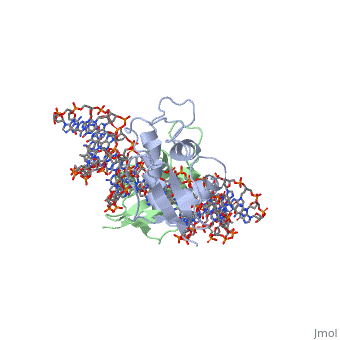1if1
INTERFERON REGULATORY FACTOR 1 (IRF-1) COMPLEX WITH DNAINTERFERON REGULATORY FACTOR 1 (IRF-1) COMPLEX WITH DNA
Structural highlights
Function[IRF1_MOUSE] Transcriptional regulator which displays a remarkable functional diversity in the regulation of cellular responses. These include the regulation of IFN and IFN-inducible genes, host response to viral and bacterial infections, regulation of many genes expressed during hematopoiesis, inflammation, immune responses and cell proliferation and differentiation, regulation of the cell cycle and induction of growth arrest and programmed cell death following DNA damage. Stimulates both innate and acquired immune responses through the activation of specific target genes and can act as a transcriptional activator and repressor regulating target genes by binding to an interferon-stimulated response element (ISRE) in their promoters. Its target genes for transcriptional activation activity are: genes involved in anti-viral response, such as IFN-alpha/beta, DDX58/RIG-I, TNFSF10/TRAIL, OAS1/2, PIAS1/GBP, EIF2AK2/PKR and RSAD2/viperin; antibacterial response, such as NOS2/INOS; anti-proliferative response, such as p53/TP53, LOX and CDKN1A; apoptosis, such as BBC3/PUMA, CASP1, CASP7 and CASP8; immune response, such as IL7, IL12A/B and IL15, PTGS2/COX2 and CYBB; DNA damage responses and DNA repair, such as POLQ/POLH; MHC class I expression, such as TAP1, PSMB9/LMP2, PSME1/PA28A, PSME2/PA28B and B2M and MHC class II expression, such as CIITA. Represses genes involved in anti-proliferative response, such as BIRC5/survivin, CCNB1, CCNE1, CDK1, CDK2 and CDK4 and in immune response, such as FOXP3, IL4, ANXA2 and TLR4. Stimulates p53/TP53-dependent transcription through enhanced recruitment of EP300 leading to increased acetylation of p53/TP53. Plays an important role in immune response directly affecting NK maturation and activity, macrophage production of IL12, Th1 development and maturation of CD8+ T-cells. Also implicated in the differentiation and maturation of dendritic cells and in the suppression of regulatory T (Treg) cells development. Acts as a tumor suppressor and plays a role not only in antagonism of tumor cell growth but also in stimulating an immune response against tumor cells.[1] [2] [3] [4] [5] [6] Evolutionary Conservation Check, as determined by ConSurfDB. You may read the explanation of the method and the full data available from ConSurf. Publication Abstract from PubMedThe family of interferon regulatory factor (IRF) transcription factors is important in the regulation of interferons in response to infection by virus and in the regulation of interferon-inducible genes. The IRF family is characterized by a unique 'tryptophan cluster' DNA-binding region. Here we report the crystal structure of the IRF-1 region bound to the natural positive regulatory domain I (PRD I) DNA element from the interferon-beta promoter. The structure provides the first three-dimensional view of a member of the growing IRF family, revealing a new helix-turn-helix motif that latches onto DNA through three of the five conserved tryptophans. The motif selects a short GAAA core sequence through an obliquely angled recognition helix, with an accompanying bending of the DNA axis in the direction of the protein. Together, these features suggest a basis for the occurrence of GAAA repeats within IRF response elements and provide clues to the assembly of the higher-order interferon-beta enhancesome. Structure of IRF-1 with bound DNA reveals determinants of interferon regulation.,Escalante CR, Yie J, Thanos D, Aggarwal AK Nature. 1998 Jan 1;391(6662):103-6. PMID:9422515[7] From MEDLINE®/PubMed®, a database of the U.S. National Library of Medicine. See AlsoReferences
|
| ||||||||||||||
